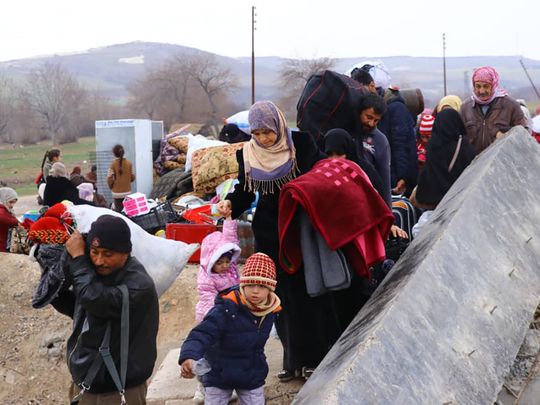
The more we look at the misery of that haunted ruin called Syria, the more the misery of its people looks back at us, leaving our moral compass suffused with a sense of grim havoc.
Since December 1, following several assaults on the country’s dwindling rebel-held areas in Idlib province by Syrian forces — aided by relentless Russian air power — roughly 830,000 people have been uprooted from their homes, with at least 130,000 displaced in the last two weeks.
That makes it by far the most urgent refugee crisis of the entire nine-year war.
Imagine this wretched sea of humanity — men, women and children — fleeing north, crowding in tents and sleeping in the open fields, under trees and by the wayside, in harsh winter conditions.
And there they sit, waiting for Godot, as it were, having travelled miles on foot or on overloaded trucks, on an agonising, at times dangerous journey to, well, nowhere, given the fact that Turkey, unwilling to admit any more refugees, has long had its borders nailed shut.
We need, in short, an understanding of the aesthetic roots of the inhuman — the inhuman we see, say, in the spectacle of nine children, their lives hounded to oblivion, who had died of hypothermia, in the dead of winter, in a placeless place on the Syrian-Turkish border, as their parents, we imagine, addressed them one last time while reading prayers over their little, snow-covered, makeshift graves
Air strikes continue
The freezing temperatures have already contributed to the death of dozens of people, including, tragically, nine children.
Meanwhile, the relentless air strikes by Russian warplanes continue to do what they have done best since September 2015 — the year Moscow launched its military campaign — which is to bomb, in addition to rebel strongholds, civilian sites, including market places, town squares, bakeries and even hospitals.
(In 2019 alone, there were 85 attacks on health care facilities in Idlib, Michelle Nunn, president of CARE, claimed last month.)
What is even more disturbing is the widely reported bombings targeting (hold on to your incredulous hat) fleeing families on the road.
A million uprooted
For Russia, of course, it is all a Kabuki dance, cynical theatre meant to lend credence to Moscow’s avowal that its military is there to aid the Syrian government defeat “terrorists” and “reactionary Islamists”, while leaders in the Kremlin pursue their geopolitical ambitions in the region.
And never mind that the cost of all that is human suffering on a scale and of a kind not seen since 1999, when Russian forces unleashed their terrifying firepower against Grozny, the rustic capital of Chechnya, reducing it to a smashed, smouldering husk reminiscent not so much of Dresden as of Hiroshima.
Close to a million Syrian refugees uprooted just over the last two and a half months! Refugees huddled in tents, in the open fields, by the wayside, under trees, in freezing temperatures!
How could that be? How could we engage the dread that this image evokes? Have we so internalised the wantonness of it all over the last nine years — and internalised it perhaps subliminally — that today we have ceased to turn away from it in abhorrent disbelief?
These are existentially pressing questions that we need to ask, not just in self-address but in public discourse.
We need, in short, an understanding of the aesthetic roots of the inhuman — the inhuman we see, say, in the spectacle of nine children, their lives hounded to oblivion, who had died of hypothermia, in the dead of winter, in a placeless place on the Syrian-Turkish border, as their parents, we imagine, addressed them one last time while reading prayers over their little, snow-covered, makeshift graves.
Gone to rack and ruin
And, yes, lets not forget, beyond the bombs, beyond the carnage, beyond the unspeakable suffering, the other victims of this conflict: Idlib’s ancient, now ruined riches, including the countless churches built during the Byzantine era — between the 4th and 6th centuries — which to experts had provided evidence of the influence of Syrian styles on the subsequent evolution of European Romanesque and Gothic architecture, making them the ancestors of France’s beloved Notre Dame Cathedral.
Now, thanks to the war, these treasures have all gone to rack and ruin. In brief, destroy not just the people but the culture that had defined the soul of their history.
Meanwhile, we wonder how these Syrian folks, along with the nation they came from, would heal and get back being themselves again, with their misery ending on a note of grace.
— Fawaz Turki is a journalist, lecturer and author based in Washington. He is the author of The Disinherited: Journal of a Palestinian Exile.










